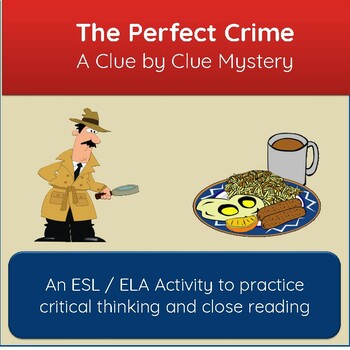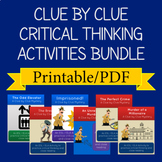Critical Thinking Mystery Activity: The Perfect Crime
- PDF
What educators are saying
Also included in
- By popular demand, all my clue by clue mysteries PDF (printable) format in one big bundle, plus a free mystery story organizing worksheet. Be sure to check the list above to see the exact list of Clue by Clue Mysteries!Each individual mystery is in PDF format and contains:A cover imageComprehensivePrice $90.00Original Price $123.00Save $33.00
Description
In this engaging mystery activity, students have to follow the clues to figure out how a woman killed her husband without anyone suspecting anything! In fact, it's unclear whether or not she did anything wrong at all? Can they follow the clues and use their critical thinking skills and reading strategies to figure it out!
This is a PDF Printable copy that works well for a small group activity in a face-to-face classroom. Click here for the PowerPoint version. Or Click here for the Google Slides version.
Inside find:
- Teacher Notes on how to use the clues, including suggested warm-ups.
- 9 clues to be given to students one by one.
- Hints in the form of guiding questions to help students figure out what happened.
- The Solution: Students are not left hanging. There is a clear solution that follows from the clues.
- Extension Questions (optional) to extend the activity by discussing if the woman is guilty or not and other ways to commit a "perfect" murder.
What is a Clue by Clue Mystery?
It's a great warm-up, filler, or time killer for early finishers. Students are given a mystery to solve--whodunit or how did they do it or why. They have to figure it out by reading a series of clues, one at a time. As they receive each clue, they speculate on its significance and what it tells them about the situation.
Once they have received all the clues, they should have enough information to figure it out!
While students are solving the mysteries they are also developing their spoken language skills, using language such as:
- Modal verbs of speculation: She must have forgotten her keys, It could have been the butler
- Opinion language: I think...., I’m positive..., I’m not sure...
- Hedging: It’s possible, probably, maybe, it’s not impossible.
- Conclusions: That means that...
- Emphasis: There’s no way that...
- Hypotheticals: What if he didn’t do it, If he was at the movies, he couldn’t have done it.
They are also a lot of fun!
Enjoy this? Check out my entire Mystery Section with more clue by clues in different formats. I also have activities to help students write their own mysteries and more!
And please leave a review. It helps others find this resource and gives me valuable feedback when creating new ones!






